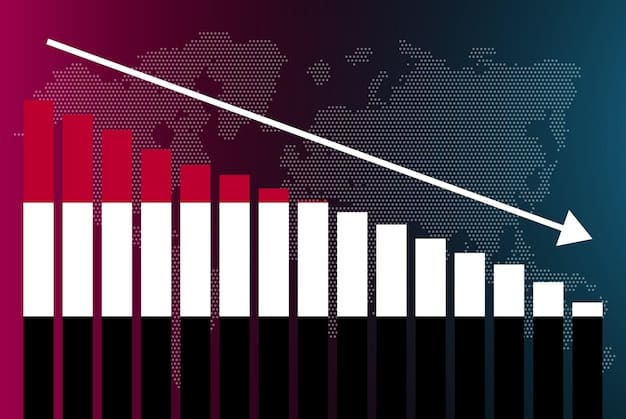Inflation Rate Dips: What It Means for Your Investments

The latest inflation data shows a decrease to 3.2%, prompting investors to reassess strategies. This shift impacts fixed income, equities, and real estate, requiring a nuanced understanding to navigate potential market adjustments and maintain portfolio resilience.
The latest economic reports reveal a noteworthy shift: the inflation rate has dipped to 3.2%. Understanding what this means for your investments is crucial for making informed financial decisions in today’s dynamic market.
Inflation Rate at 3.2%: A Financial Overview
The recent drop in the inflation rate to 3.2% has sparked considerable discussion among economists and investors. This figure represents a significant milestone in the ongoing efforts to stabilize prices and manage economic growth. Let’s delve into what this rate signifies and its broader implications for the financial landscape.
Understanding the 3.2% Inflation Rate
The 3.2% inflation rate indicates the pace at which the general level of prices for goods and services is increasing. It’s a key metric used by the Federal Reserve to gauge the health of the economy and make informed decisions about monetary policy.
How Inflation Impacts the Economy
Inflation can influence consumer spending, business investments, and overall economic activity. A moderate level of inflation is generally considered healthy, encouraging spending and investment. However, when inflation rises too quickly, it can erode purchasing power and destabilize the economy.

Key points to consider:
- The 3.2% rate suggests a cooling down of previously higher inflation levels.
- This rate can affect the Federal Reserve’s decisions on interest rates.
- Investors should reassess their portfolios in light of these changes.
In conclusion, the dip in the inflation rate to 3.2% signals a shift in the economic environment. Grasping its significance and impact is critical for investors aiming to navigate the evolving financial landscape.
Impact on Fixed Income Investments
Fixed income investments, such as bonds, are particularly sensitive to changes in inflation rates. The recent dip to 3.2% introduces new dynamics for these investments. Understanding these dynamics is essential for optimizing returns and managing risk in your fixed income portfolio.
Fixed income investments encompass a variety of financial instruments that provide a fixed return over a specified period. These include government bonds, corporate bonds, and municipal bonds. Each type carries its own set of risks and rewards, making it crucial to align investment choices with your financial goals.
How Lower Inflation Affects Bond Yields
When inflation decreases, bond yields tend to follow suit. Lower inflation reduces the pressure on central banks to raise interest rates, which can lead to lower yields on newly issued bonds. Existing bondholders may see the value of their investments increase.
Strategies for Fixed Income Investors
In a lower inflation environment, fixed income investors may consider:
- Extending the duration of their bond portfolios to capture potential price appreciation.
- Investing in high-quality bonds to minimize credit risk.
- Diversifying their fixed income holdings across different sectors and maturities.
In summary, the drop in the inflation rate to 3.2% presents both opportunities and challenges for fixed income investors. Adapting your strategies to this new environment can help you achieve your financial objectives.
Equity Market Reactions
The equity market, comprising stocks and shares, often reacts swiftly to changes in economic indicators, including inflation rates. A decrease in inflation to 3.2% can have varied effects on different sectors and investment strategies. Understanding these reactions is crucial for equity investors.
The equity market is a dynamic arena where stock prices are influenced by a multitude of factors, including economic data, corporate earnings, and investor sentiment. Lower inflation can impact corporate profitability and investor expectations, leading to shifts in stock valuations.
Sector-Specific Impacts
Some sectors may benefit more than others from lower inflation. For instance:
- Consumer discretionary companies may see increased sales as consumers have more disposable income.
- Technology companies may benefit from lower borrowing costs, facilitating innovation and expansion.
- Utilities may experience stable demand and reduced input costs, enhancing profitability.
Investment Strategy Adjustments
Equity investors might consider:
- Reassessing sector allocations to favor those that stand to gain from lower inflation.
- Focusing on companies with strong balance sheets and consistent earnings growth.
- Maintaining a diversified portfolio to mitigate risks associated with market volatility.
In essence, the equity market’s response to a 3.2% inflation rate depends on a complex interplay of factors. Adapting your investment approach to these dynamics can help you capitalize on emerging opportunities.

Real Estate Investment Considerations
Real estate, often considered a hedge against inflation, also feels the effects of fluctuating inflation rates. The dip to 3.2% warrants a reassessment of real estate investment strategies. Understanding how this change impacts the real estate market is vital for property investors.
Real estate investments include residential properties, commercial buildings, and real estate investment trusts (REITs). These investments can provide income through rental payments and capital appreciation. Lower inflation can influence rental rates, property values, and the overall attractiveness of real estate as an investment.
Impact on Property Values and Rental Yields
Lower inflation can lead to:
- Stabilization of property values as borrowing costs remain manageable.
- Potential moderation of rental rate increases, affecting income streams for landlords.
- Increased demand for properties as lower inflation boosts consumer confidence and affordability.
Strategies for Real Estate Investors
Real estate investors might consider:
- Focusing on properties in high-demand areas with strong rental markets.
- Refinancing existing mortgages to take advantage of lower interest rates.
- Diversifying their real estate holdings across different property types and geographic locations.
In conclusion, the real estate market’s reaction to a 3.2% inflation rate hinges on various factors. Tailoring your investment strategies to these dynamics can help you achieve your real estate investment goals.
Alternative Investments in a Low Inflation Environment
Alternative investments, such as commodities, private equity, and hedge funds, offer diversification beyond traditional asset classes. The recent inflation rate of 3.2% may influence the performance and attractiveness of these investments. Investors should understand these effects to diversify their portfolios effectively.
Alternative investments provide opportunities to diversify a portfolio and potentially enhance returns. These investments often have low correlation with traditional assets, making them valuable tools for managing risk. However, they also come with unique challenges and require careful due diligence.
Potential Opportunities
In a low inflation environment, consider:
- Commodities: Demand for raw materials can be influenced by moderate inflation and economic growth.
- Private Equity: Lower interest rates can fuel deal activity and corporate valuations.
- Hedge Funds: Strategies focused on relative value and market inefficiencies may thrive in stable economic conditions.
Risk Considerations
Investors should be aware of potential downsides:
- Commodities can be volatile and influenced by geopolitical events and supply/demand imbalances.
- Private equity investments are illiquid and require a long-term investment horizon.
- Hedge funds charge high fees and may not always deliver consistent returns.
In summary, alternative investments can play a valuable role in a diversified portfolio, especially in a low inflation environment. Diligence and aligning allocation decisions with broader financial goals remains essential.
Portfolio Adjustments and Long-Term Planning
Navigating the complexities of a 3.2% inflation rate requires a strategic approach to portfolio adjustments and long-term financial planning. Investors must adapt their strategies to balance risk and return while considering their unique financial goals and time horizons.
Effective portfolio management involves ongoing monitoring, rebalancing, and adjustments based on economic conditions and market dynamics. Long-term financial planning entails setting clear goals, developing a roadmap to achieve them, and regularly reviewing progress.
Assessing Your Risk Tolerance
Start by assessing your risk tolerance, which will influence the types of investments you include in your portfolio. Consider:
- Your age and investment time horizon.
- Your financial goals and income needs.
- Your comfort level with market volatility.
Seeking Financial Advice
Consider seeking guidance from a qualified financial advisor with:
- Personalized recommendations based on your individual circumstances.
- Expert insights on asset allocation and investment selection.
- Ongoing support to help you stay on track toward your financial goals.
In conclusion, prudent portfolio adjustments and proactive long-term financial planning are critical for navigating a dynamic investment landscape.
| Key Point | Brief Description |
|---|---|
| 📉 Inflation Dip | Inflation drops to 3.2%, affecting investment strategies. |
| 📊 Fixed Income | Bond yields may decrease; consider extending portfolio duration. |
| 📈 Equity Market | Consumer discretionary and tech sectors may benefit. |
| 🏘️ Real Estate | Property values stabilize; focus on high-demand areas. |
Frequently Asked Questions
▼
An inflation rate of 3.2% indicates a moderate increase in the prices of goods and services. It suggests the economy is growing, but it’s important to monitor to ensure it doesn’t accelerate too quickly.
▼
Lower inflation typically leads to lower bond yields. Existing bondholders may see their investments increase in value, while new bond issuances may offer lower returns.
▼
Sectors like consumer discretionary and technology often benefit from lower inflation. Consumers have more disposable income, and companies face lower borrowing costs for innovation and expansion.
▼
Real estate investors should focus on properties in high-demand areas and consider refinancing mortgages to take advantage of lower interest rates, balancing income and growth.
▼
Yes, diversification is crucial. Consider alternative investments like commodities and private equity to balance risk and enhance returns, adapting to broader economic trends.
Conclusion
In conclusion, the dip in the inflation rate to 3.2% requires investors to reassess their financial strategies across various asset classes. By understanding the implications for fixed income, equities, real estate, and alternative investments, you can position your portfolio to navigate potential market adjustments and achieve your long-term financial goals.





